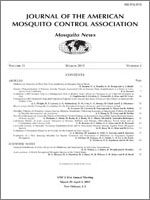Since its introduction and establishment in Italy during the early 1990s, the Asian tiger mosquito, Aedes albopictus, has spread over large parts of Italy and other Mediterranean countries. Aedes albopictus is both a nuisance and a competent vector for various arthropod-borne pathogens. Although efficient traps for Ae. albopictus exist and are used for population monitoring, their use as a control tool has not yet been studied. We evaluated Biogents BG-Sentinel mosquito traps, used with the BG Lure, as control tools in northern Italy. The trial was performed as a controlled experiment in which 3 intervention sites, equipped with 7 or 8 BG-Sentinel traps each, were matched with 3 comparable control sites. Trap density ranged from 1 trap per 150 m2 to 1 per 350 m2. Mosquito populations were monitored at both the intervention and control sites with weekly human landing collections (HLC) and ovitraps. Between 64% and 87% fewer Ae. albopictus individuals were collected by HLC at the intervention sites with the BG-Sentinel mosquito traps, as compared to the untreated control sites. These results indicate that the sustained use and proper placement of efficient mosquito traps can significantly reduce Ae. albopictus biting pressure.
How to translate text using browser tools
1 March 2015
Evaluation of BG-Sentinel Trap as a Management Tool to Reduce Aedes albopictus Nuisance in an Urban Environment in Italy
Christian Englbrecht,
Scott Gordon,
Claudio Venturelli,
Andreas Rose,
Martin Geier
ACCESS THE FULL ARTICLE
It is not available for individual sale.
This article is only available to subscribers.
It is not available for individual sale.
It is not available for individual sale.
Aedes albopictus
BG-Sentinel mosquito trap
Culicidae
mosquito control
nuisance reduction





